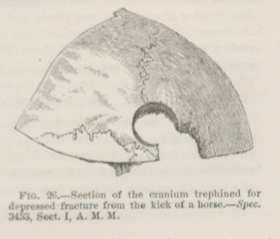Title: V——, Charles
Source text: Surgeon General Joseph K. Barnes, United States Army, The Medical and Surgical History of the War of the Rebellion. (1861–65.), Part 1, Volume 2 (Washington, D.C.: Government Printing Office, 1870), 60.
Civil War Washington ID: med.d1e3734
TEI/XML: med.d1e3734.xml
CASE.—Private Charles V——, Signal Corps, received, on February 24th, 1862, at Georgetown, D. C., a kick from a horse; the sharp cork of the shoe penetrating the cranium at the anterior inferior angle of the parietal bone, driving fragments of the internal table inward, penetrating the dura mater and rupturing the middle meningeal artery. He was seen by Acting Assistant Surgeon John S. Billings, six hours after the reception of the injury. He was comatose, and presented the usual signs of compression of the brain from depressed fracture. Dr. Billings applied the trephine and removed the depressed fragments, and also about two ounces of coagulated blood. The patient immediately came to his senses, and did well for four days, when symptoms of cerebro-meningitis set in. The patient was then transferred to the Union Hotel Hospital. Active treatment was unavailing, and death followed in two days, or on March 2d, 1862. The autopsy showed effusion of lymph over the whole of the right hemisphere of the cerebrum. A portion of the cranium, showing the extent of bone removed, was contributed, with a memorandum of the case, to the Army Medical Museum by Dr. Billings. It is represented in the adjacent wood cut, (FIG. 26.)
